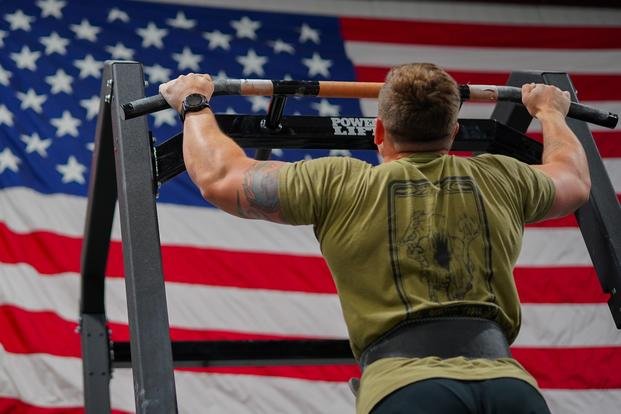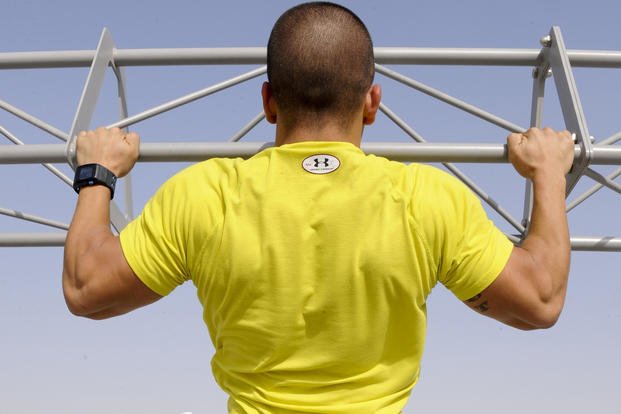Many people struggle with pullups at first, but with practice, this exercise can be rewarding and can build upper body pulling and grip strength. Fortunately, you can still build the necessary strength and endurance through a combination of weight exercises and calisthenics.
Pullups are also transferable to other skills, such as climbing over walls and fences and using ropes and caving ladders. Below, you’ll find a comprehensive 4-5 set circuit designed to help you progress toward your first or multiple pullups.
Pullups require a combination of back, shoulder, arm, grip and core strength, as well as proper technique. If you’re not yet able to perform one, it’s often due to underdeveloped strength in one or more of these areas, or simply because your body needs more support to move efficiently through space. The more weight you’re lifting, the more strength is required, which makes pullups a particularly advanced movement for many people.
Read Next: How Should I Prepare for Military Weighted Pullup Tests?
That’s where a smart pulling circuit comes in: To build the strength, coordination and confidence needed to get there.
Effective Training Circuit for Those Who Can’t Yet Do Pullups
This circuit combines weight training and calisthenics to target the muscles used in pullups. Perform the following circuit for four to five rounds, resting for 3 to 4 minutes between sets. For best results, work through the circuit before resting and strive to do this routine two to three times a week:
Repeat 4 to 5 times:
- Pullups – Try to do one. If you cannot, then do a negative pullup for two reps
- Assisted Pullups – 6-8 reps (with bands, spotter, or machine assist)
- Inverted Rows – 6-8 reps (low bar or barbell in squat rack)
- Pulldowns – 6-8 reps (Machine or bands)
- Dumbbell Bicep Curls – 10-12 reps
- Plank pose – 1 minute
- Cool down with easy cardio like walking, jogging, biking – 3-4 minutes
Notes on Exercises in the Circuit
Pullups: Start by getting used to your bodyweight and hanging from the bar. Eventually, you will be able to control your descent (negative pullup) and create upward pulling strength to get your first one, but this requires feeling your bodyweight on the bar each set. If you cannot do a pullup, get yourself over the bar by jumping or stepping on something, then slowly let yourself down, fighting the gravity of the downward pullup motion. Shoot for a 5-second descent when doing the negative pullup.
Assisted pullups come in many varieties. The goal is to perform them immediately after failing a real pullup. If you have access to a resistance band or an assisted pullup machine, use it. Otherwise, jump or step up to the top position of a pullup, then slowly lower yourself down over 3 to 5 seconds. This eccentric movement helps build strength in the muscles used for pullups.
Inverted rows: Set up a barbell in a squat rack or use a dip bar. Lie underneath it, grab the bar with an overhand grip, and pull your chest toward the bar while keeping your body in a straight line. You can make the movement easier or harder by adjusting the bar height or your foot position. Inverted rows strengthen your pulling muscles, grip and core.
Lat pulldowns or resistance band pulldowns: If you have access to a cable machine, perform pulldowns. If not, loop a resistance band over a door or pullup bar, kneel below, and pull the band down to your chest, simulating the pullup motion.
Read More: Workout Do’s and Don’ts for Those Trying to Max Out Pullups
Dumbbell or bicep curls: Top off the circuit with dumbbell bicep curls to work one of the primary movers of the pullup. With a dumbbell in each hand (or a barbell), keep your back straight and curl the weights up toward your shoulders from the hips, bending at the elbows.
Plank pose: This is included because core strength is helpful for pullups. Hold a standard plank position and gradually build up to 2 to 3 minutes over time.

Be Patient and Consistent to See Progress
Even if you can’t do a pullup today, consistent training with this circuit will help you develop the strength, technique and confidence you need.
Here are some more tips to success on your journey to doing pullups:
- Perform this circuit two to three times per week, allowing two days’ worth of upper body rest for muscle recovery between workouts. It is fine to do leg days, cardio and stretching in the meantime.
- Gradually increase reps or resistance as you get stronger.
- Test your pullup ability every few weeks. You’ll likely notice improvement!
Remember, your first pullup is a strength exercise. Your 20th pullup is a muscle stamina exercise. This circuit helps you with both elements of fitness, not only to help you get your first pullup, but also to achieve many more after that. The first pullup is the hardest. After that, the growth to double digits comes quickly.
Want to Learn More About Military Life?
Whether you’re thinking of joining the military, looking for fitness and basic training tips, or keeping up with military life and benefits, Military.com has you covered. Subscribe to Military.com to have military news, updates and resources delivered directly to your inbox.
Story Continues
Read the full article here





